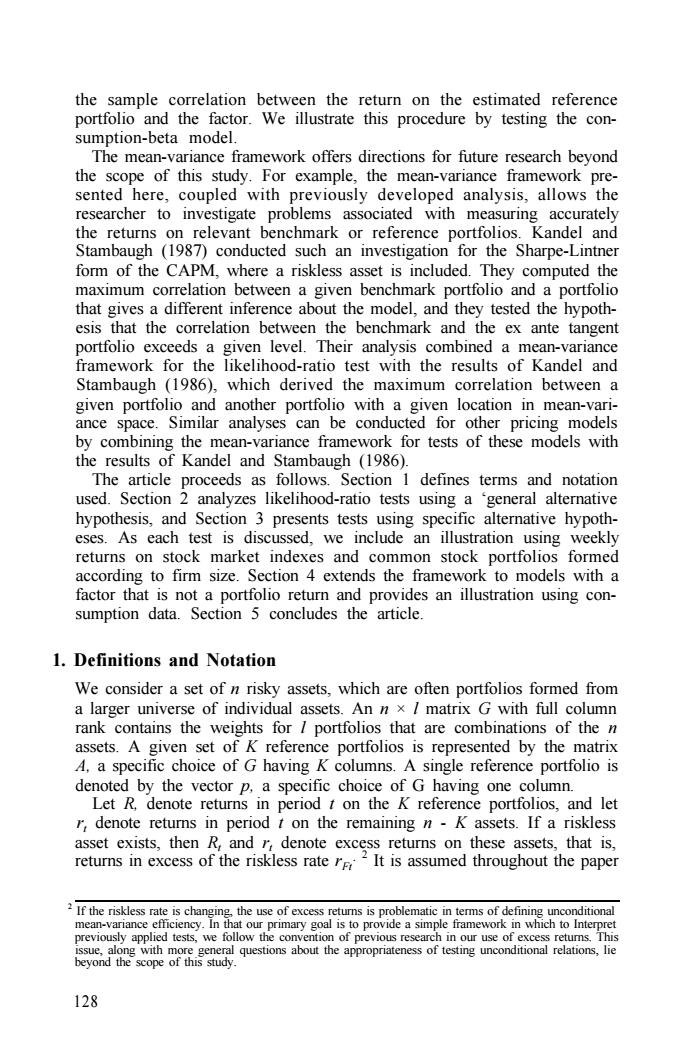正在加载图片...

the sample correlation between the return on the estimated reference portfolio and the factor.We illustrate this procedure by testing the con- sumption-beta model. The mean-variance framework offers directions for future research beyond the scope of this study.For example,the mean-variance framework pre- sented here,coupled with previously developed analysis,allows the researcher to investigate problems associated with measuring accurately the returns on relevant benchmark or reference portfolios.Kandel and Stambaugh (1987)conducted such an investigation for the Sharpe-Lintner form of the CAPM,where a riskless asset is included.They computed the maximum correlation between a given benchmark portfolio and a portfolio that gives a different inference about the model,and they tested the hypoth- esis that the correlation between the benchmark and the ex ante tangent portfolio exceeds a given level.Their analysis combined a mean-variance framework for the likelihood-ratio test with the results of Kandel and Stambaugh (1986),which derived the maximum correlation between a given portfolio and another portfolio with a given location in mean-vari- ance space.Similar analyses can be conducted for other pricing models by combining the mean-variance framework for tests of these models with the results of Kandel and Stambaugh (1986). The article proceeds as follows.Section 1 defines terms and notation used.Section 2 analyzes likelihood-ratio tests using a general alternative hypothesis,and Section 3 presents tests using specific alternative hypoth- eses.As each test is discussed,we include an illustration using weekly returns on stock market indexes and common stock portfolios formed according to firm size.Section 4 extends the framework to models with a factor that is not a portfolio return and provides an illustration using con- sumption data.Section 5 concludes the article. 1.Definitions and Notation We consider a set of n risky assets,which are often portfolios formed from a larger universe of individual assets.An n x matrix G with full column rank contains the weights for portfolios that are combinations of the n assets.A given set of K reference portfolios is represented by the matrix A,a specific choice of G having K columns.A single reference portfolio is denoted by the vector p,a specific choice of G having one column. Let R,denote returns in period t on the K reference portfolios,and let r,denote returns in period t on the remaining n-K assets.If a riskless asset exists,then R,and r,denote excess returns on these assets,that is, returns in excess of the riskless rate reIt is assumed throughout the paper If the riskless rate is changing,the use of excess returns is problematic in terms of defining unconditional mean-variance efficiency.In that our primary goal is to provide a simple framework in which to Interpret previously applied tests,we follow the convention of previous research in our use of excess retums.This issue,along with more general questions about the appropriateness of testing unconditional relations,lie beyond the scope of this study. 128the sample correlation between the return on the estimated reference portfolio and the factor. We illustrate this procedure by testing the consumption-beta model. The mean-variance framework offers directions for future research beyond the scope of this study. For example, the mean-variance framework presented here, coupled with previously developed analysis, allows the researcher to investigate problems associated with measuring accurately the returns on relevant benchmark or reference portfolios. Kandel and Stambaugh (1987) conducted such an investigation for the Sharpe-Lintner form of the CAPM, where a riskless asset is included. They computed the maximum correlation between a given benchmark portfolio and a portfolio that gives a different inference about the model, and they tested the hypothesis that the correlation between the benchmark and the ex ante tangent portfolio exceeds a given level. Their analysis combined a mean-variance framework for the likelihood-ratio test with the results of Kandel and Stambaugh (1986), which derived the maximum correlation between a given portfolio and another portfolio with a given location in mean-variance space. Similar analyses can be conducted for other pricing models by combining the mean-variance framework for tests of these models with the results of Kandel and Stambaugh (1986). The article proceeds as follows. Section 1 defines terms and notation used. Section 2 analyzes likelihood-ratio tests using a ‘general alternative hypothesis, and Section 3 presents tests using specific alternative hypotheses. As each test is discussed, we include an illustration using weekly returns on stock market indexes and common stock portfolios formed according to firm size. Section 4 extends the framework to models with a factor that is not a portfolio return and provides an illustration using consumption data. Section 5 concludes the article. 1. Definitions and Notation We consider a set of n risky assets, which are often portfolios formed from a larger universe of individual assets. An n × l matrix G with full column rank contains the weights for l portfolios that are combinations of the n assets. A given set of K reference portfolios is represented by the matrix A, a specific choice of G having K columns. A single reference portfolio is denoted by the vector p, a specific choice of G having one column. Let R, denote returns in period t on the K reference portfolios, and let rt denote returns in period t on the remaining n - K assets. If a riskless asset exists, then Rt and rt denote excess returns on these assets, that is, returns in excess of the riskless rate rFt· 2 It is assumed throughout the paper 2 If the riskless rate is changing, the use of excess returns is problematic in terms of defining unconditional mean-variance efficiency. In that our primary goal is to provide a simple framework in which to Interpret previously applied tests, we follow the convention of previous research in our use of excess returns. This issue, along with more general questions about the appropriateness of testing unconditional relations, lie beyond the scope of this study. 128